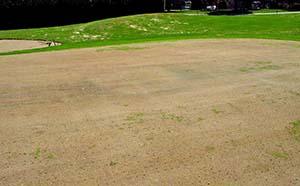 It has been a challenging winter, with record amounts of snowfall and cold temperatures the norm rather than the exception in many parts of the country.
It has been a challenging winter, with record amounts of snowfall and cold temperatures the norm rather than the exception in many parts of the country.The threat of winter injury was so severe that 372 people recently tuned in to a Webinar on the topic that was conducted by Kevin Frank, Ph.D., of Michigan State, Bill Kreuser, Ph.D., of the University of Nebraska and Frank Rossi, Ph.D., of Cornell University.
Grigg Brothers, who co-sponsored the online seminar along with Aquatrols, also has developed a checklist of advice on recovering from winter damage.
Grigg Brothers' agronomic team recommends the following:
Where injury is severe, close the greens (or at least the damaged portion) and direct play to temporary greens. Traffic will compromise recovery significantly and delay restoring acceptable playing quality. In fact, playing on a green under recovery could double or triple recovery time.
Raise the height of cut and equip mowers with smooth out-front rollers to reduce stress and wear injury to existing/new plants. Smooth rollers make the mowers much less aggressive than grooved or spiral rollers. Mow as infrequently as possible.
An application of black or other dark-colored topdressing sand at a rate of 200 to 400 pounds per 1,000 square feet could help warm the soil for seed germination and an increased rate of growth.
Permeable turf covers can also be used to stimulate soil warmth and accelerate growth. Be sure to monitor disease pressure under covers.
Grigg Brothers also recommends developing a fertilization program that includes applications every seven days to promote recovery.

